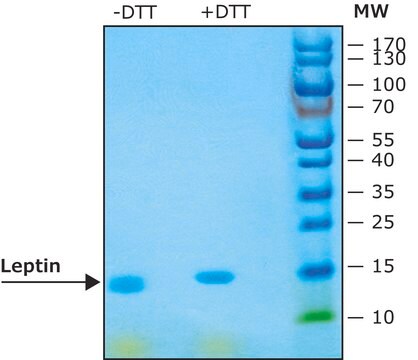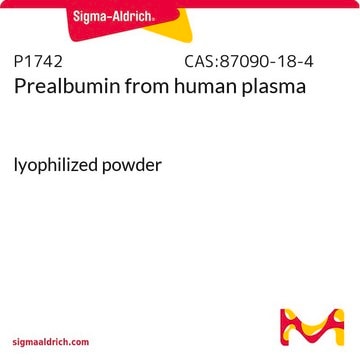L4146
Leptin human
≥97% (SDS-PAGE), recombinant, expressed in E. coli, lyophilized powder
Sinónimos:
OB
About This Item
Productos recomendados
recombinant
expressed in E. coli
Quality Level
sterility
sterile; 0.2 μm filtered
assay
≥97% (SDS-PAGE)
form
lyophilized powder
potency
≤3.0 ng/mL ED50/EC50
mol wt
predicted mol wt ~16 kDa
impurities
≤1.0 EU/μg endotoxin
UniProt accession no.
shipped in
ambient
storage temp.
−20°C
Gene Information
human ... LEP(3952)
Categorías relacionadas
General description
Application
- to study the effect of leptin on ACAT1 (acyl-coenzyme A:cholesterol acyltransferase 1) expression and cholesterol efflux from primary cultured human macrophages
- to study the effect of leptin on expression of IGFBP2 (insulin growth factor binding protein 2) in skeletal muscle
- to study the effect of leptin on HLA-G (human leukocyte antigen G) expression in placental trophoblasts
- to study the effect of leptin on in vitro maturation, fertilization and development of horse oocytes after ICSI (intracytoplasmic sperm injection)
Biochem/physiol Actions
Human and mouse leptin share ~84% sequence identity.
Physical form
Analysis Note
Storage Class
11 - Combustible Solids
wgk_germany
WGK 3
flash_point_f
Not applicable
flash_point_c
Not applicable
ppe
Eyeshields, Gloves, type N95 (US)
Certificados de análisis (COA)
Busque Certificados de análisis (COA) introduciendo el número de lote del producto. Los números de lote se encuentran en la etiqueta del producto después de las palabras «Lot» o «Batch»
¿Ya tiene este producto?
Encuentre la documentación para los productos que ha comprado recientemente en la Biblioteca de documentos.
Artículos
Lipid Induced Insulin Resistance
Nuestro equipo de científicos tiene experiencia en todas las áreas de investigación: Ciencias de la vida, Ciencia de los materiales, Síntesis química, Cromatografía, Analítica y muchas otras.
Póngase en contacto con el Servicio técnico







